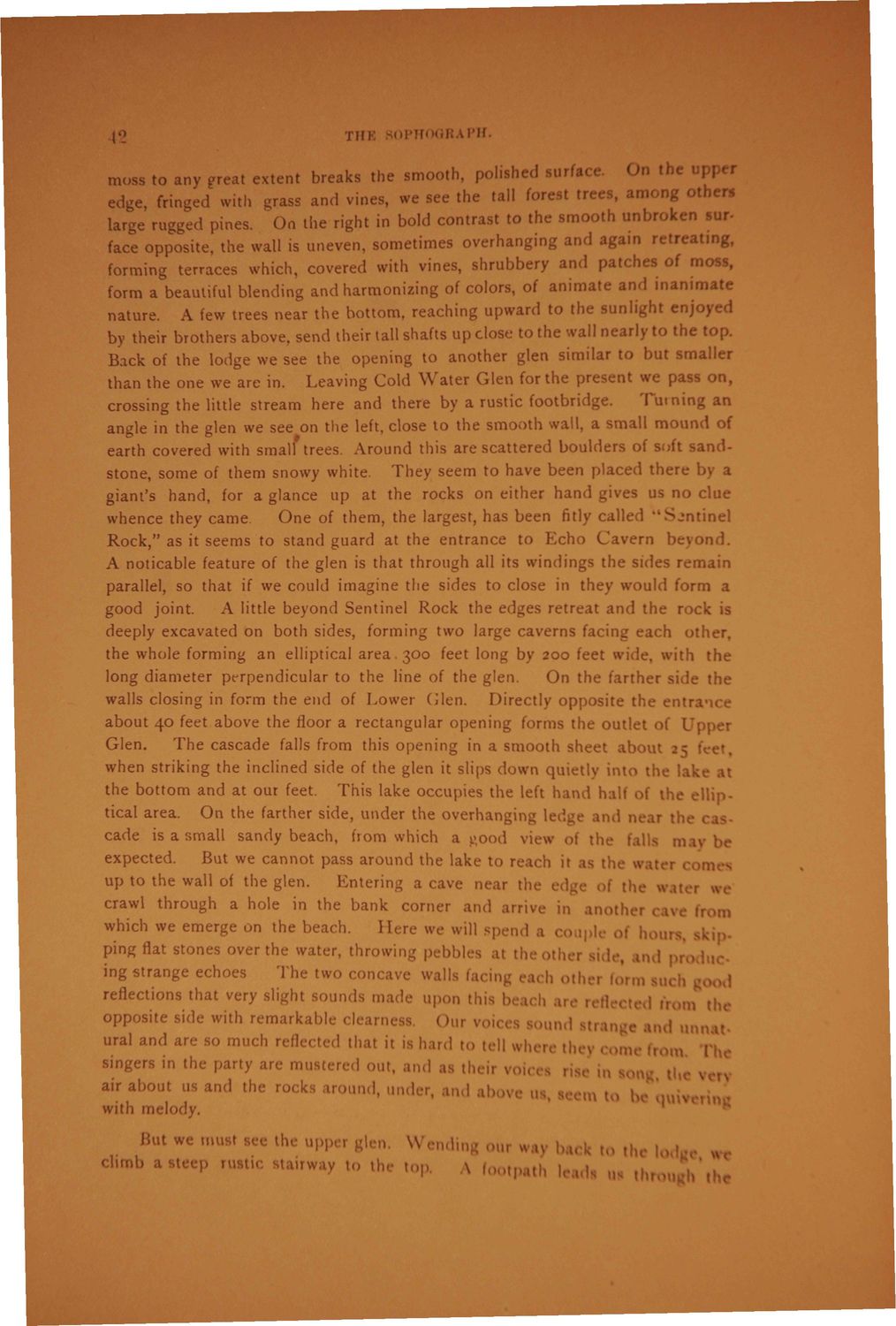| |
| |
Caption: Sophograph - 1889
This is a reduced-resolution page image for fast online browsing.

EXTRACTED TEXT FROM PAGE:
13 Tin i'H PH. moss to any great extent breaks the smooth, polished surface. On the tipp edge, fringed with grass and vines, we see the tall forest trees, among other* large rugged pines. On the right in bold contrast to the smooth unbroken sur face opposite, the wall is uneven, sometimes overhanging and again retreating forming terraces which, covered with vines, shrubbery and matches of moss, form a beautiful blending and harmonizing of colors, of animate and inanimate nature. A few trees near the bottom, reaching upward to the sunlight enjoyed by their brothers above, send their tall shafts up close to the wall nearly to the top Back of the lodge we see the opening to another glen similar to but smaller than the one we are in. Leaving Cold Water Glen for the present we pass on, crossing the little stream here and there by a rustic footbridge. Turning an angle in the glen we see on the left, close to the smooth wall, a small mound of earth covered with small trees. Around this are scattered boulders of soft sandstone, some of them snowy white. They seem to have been placed there by a giant's hand, for a glance up at the rocks on either hand gives us no clue whence they came. One of them, the largest, has been fitly called Sentinel Rock," as it seems to stand guard at the entrance to Echo Cavern beyond. A noticable feature of the glen is that through all its windings the sides remain parallel, so that if we could imagine the sides to close in they would form a good joint. A little beyond Sentinel Rock the edges retreat and the rock is deeply excavated on both sides, forming two large caverns facing each other the whole forming an elliptical area. 300 feet long by 200 feet wide, with the long diameter perpendicular to the line of the glen. On the farther side the walls closing in form the end of Lower Glen. Directly opposite the entr about 40 feet above the floor a rectangular opening forms the outlet of Upper Glen. The cascade falls from this opening in a smooth sheet about 25 when striking the inclined side of the glen it slips down quiet: into the lak t the bottom and at our feet. This lake occupies the lei I half of the ellii tical area. On the farther side, under the overhanging It ;e and near th cacade is a small sandy beach, from which a good vi< of the falls m a y b e expected. But we cannot pass around the lake to reach it as the water 1 m< up to the wall of the glen. Entering a cave near the < t of the • * crawl through a hole in the bank corner and arrive in mother c.i\ which we emerge on the beach. I [ere u ill spend a ipl h ping flat stones over the water, throwing pebbl at the other . and he ing strange echoes The two concai icin h otl rm su i reflections that very slight sounds ma< upon this h opposite side with remarkable cl trn a Our 1 ural and are so much refli I that it is hard to tell whei sin; in th rty are mustered OUl .mi as their voii air ab it us and the rock .und, und . l: with melody. und sti th. ft mn.it >me I . n llir N , Hutwen.us. theuppe. n. Wendin , «,, climb a steep - iti. iairway to the top. \ | ,,, „u. , „,
| |